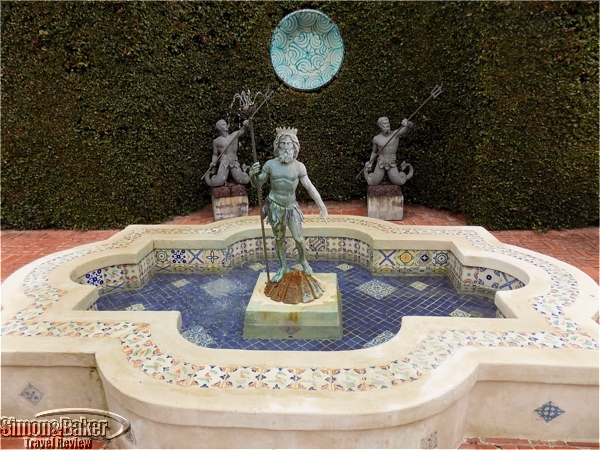
by Editor | Oct 7, 2019 | Attractions, Ecotourism
Article and photos by Scott S. Smith
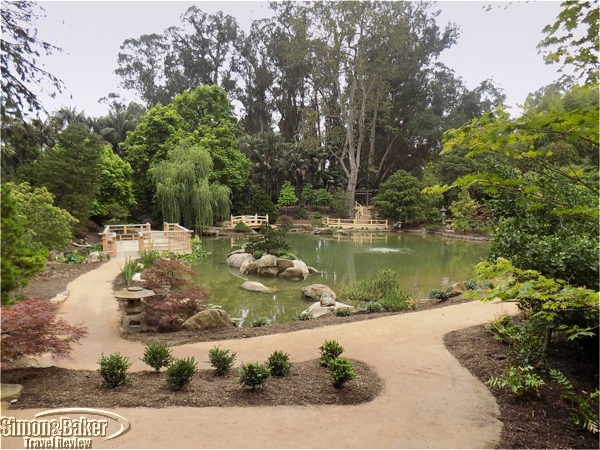
The 37-acres of Lotusland were divided into two dozen areas with a total of more than 30,000 plants.
Although my wife, Sandra Wells and I had no plans to visit Lotusland (695 Ashley Road, Santa Barbara, California 93108, +1 805 969-9990, www.lotusland.org) while we were in Santa Barbara, California we were glad we did. We had more than enough already crammed into the two days we expected to be in the area, located 90 miles north of Los Angeles and known as the Central Coast Wine Country. Perhaps because the city had been featured in the 2004 movie Sideways or because of its pleasant weather and lively arts scene many celebrities have homes there. Let’s just say we were very skeptical when we started and came away converts to the idea that gardens can be fascinating, educational, and fun.
Although the address is on Ashley Road the visitor entrance was at Cold Springs Road and Sycamore Canyon Road. Its long-in-the-making Japanese Garden had just opened two weeks prior to our visit and demand for tickets was backed up. I believe the heavy demand was due to the attraction’s location in a residential neighborhood that capped the number of visitors.
The 37-acres of Lotusland were divided into two dozen areas with a total of more than 30,000 plants, including 3,000 different types of plants, starting with the Australian Gardens at the entrance, which featured, among others, the tea trees from which the well-known healing oil is extracted. Just beyond the gate was the Japanese section (started in 1968, with a final budget of $6 million). It was being finished when we arrived, including the addition of a pagoda as well as the placement of koi and catfish in the pond.
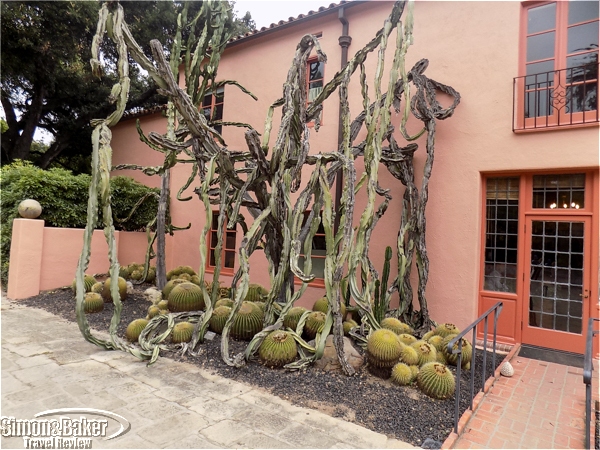
Part of Madame Ganna Walska’s home where the Lotusland offices are now located
Our guide was the well-informed Craig Morgan, whose passion for the beauty and benefits of plants in general and enthusiasm, especially for the garden, sparked our interest. When we later read The Healing Power of Gardens by Oliver Sacks, M.D., in his collected essays, Everything In Its Place, in which the famed observer of the human condition spoke about his experiences using gardens as healing centers we thought of Lotusland.
Then there is the colorful back story. Ralph Stevens bought the property in 1882 for his commercial nursery and home. His widow operated it as a guest ranch, and put it to other uses for 17 years. President Herbert Hoover visited for a garden fundraiser in 1937.
Future owner Ganna Walska was born Hanna Puacz in Brest-Liovsk, Poland, in 1887. At 25, she eloped with a Russian count and seven years later was studying singing in Paris and working under her new stage name. The following year the Russian Orthodox Church dissolved their marriage and Walska moved to New York City to escape World War I. While singing at a theater, she developed a throat ailment that took her to Joseph Fraenkel, M.D. They married 10 days later. In 1918, she made her concert debut on the same bill as legendary tenor Enrico Caruso. At her operatic debut in Havana, Cuba, at the end of the year she met Harold McCormick of International Harvester, a sponsor of the Chicago Opera.
After Fraenkel died, Walska was devastated. When she met rich heir Alexander Cochran on a voyage to Paris they married. Back in New York, she pursued her budding interest in mysticism and seances, as well as a friendship with McCormick, who arranged her debut with the Chicago Opera. A jealous Cochran forced her to cancel her performance. She divorced him in 1922 and married McCormick. He planned a 23-city United States concert tour, but she cancelled the first half when he underwent an appendectomy. He bought her a theater in Paris, which she managed for 10 years and ended up owning for nearly half a century. She made concert tours of America in 1923, 1925, and 1928, the only times during their marriage she visited the United States, despite McCormick’s residence in Chicago. He divorced her in 1931 on the grounds of desertion, but they remained friends. She lived half the year in France, half in New York, where she continued to explore Indian philosophy and her fascination with hypnotism. In 1940, she escaped France on the last commercial passenger ship before the Nazi occupation.
In New York, she studied yoga with Theos Bernard, known as the White Lama. After Walska’s next husband, a physician, died in 1940, Bernard proposed and they decided to buy what was then known as Cuesta Linda, renaming it Tibetanland, with a plan to turn it into a monastery for Tibetan monks. They began planting a variety of gardens and Walska published her autobiography, Always Room at the Top, in 1943. Three years later, they divorced and she never remarried, dedicating her life to collecting rare plants from around the world and creating a unique landscape. She renamed the garden Lotusland because the lotus, which grows in mud but produces a beautiful flower and could be a metaphor for human aspiration, is regarded by many cultures as a symbol of enlightenment and rebirth. She died in 1984. The Ganna Walska Lotusland Foundation spent the next nine years preparing the property for public tours.

There was art amidst the plants at Lotusland
Lotusland was full of sculptures, such as in the Theatre Garden, which featured a collection of grotesques, 17th century stone figures of an Italian entertainment troupe of dwarves. They were so valued that Walska had them buried with her jewelry when she fled the German occupation. Around some of the pools, like the one in the Aloe Garden (with its 140 species), were giant open clam shells, colorful abalone shells, and turquoise glass (retrieved from the slag at the factory making Sparkletts water bottles). Colored tiles, stones, and sand were used to create pictures and designs by the sides of the paths. There was a Topiary Garden featuring plants growing over wire frames that represented a menagerie, as well as an enormous working clock of flowers. According to Lotusland promotional materials Walska was one of the first garden designers to plant groups en masse to create a dramatic impression.
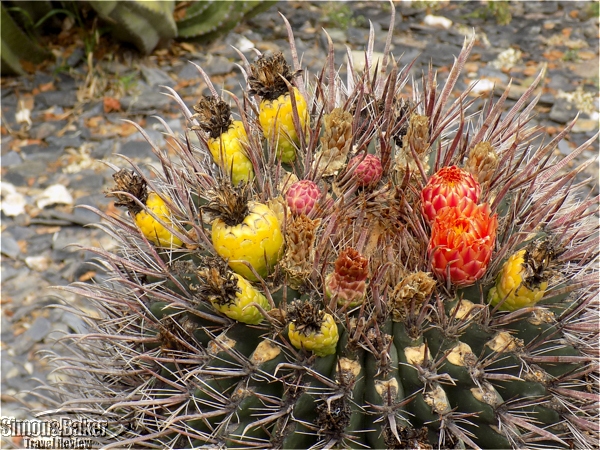
Cactus flowers provided unexpected color
The Cactus Garden contained more than 300 species (one-sixth of the total known), grouped by their country of origin (native to the Americas, they spread to the rest of the world). All have adapted to conserve water, such as thickened parts for storage and the spines, which are its leaves that curb water loss by reducing air flow close to the stem and providing some shade (as well as defense against critters). Unlike other plants, their photosynthesis process, in which carbon dioxide enters the plant and water escapes, cacti delay the latter until night, reducing water loss. A mature saguaro can absorb as much as 200 gallons of water in a single rainstorm. We were amazed at how cacti differed in their shapes, colors, flowers, and the way they twisted to adapt to their neighbors.
It was surprising to come across other species in the Tropical Garden, such as the epiphyllum native to the Brazilian rainforest. We had never thought of cactus being a tropical plant.
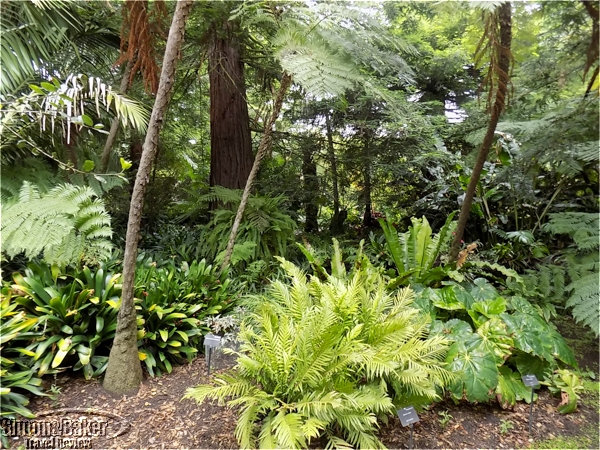
Broad-leafed begonias among the ferns and a mature Dragon Tree, with its umbrella-like branches.
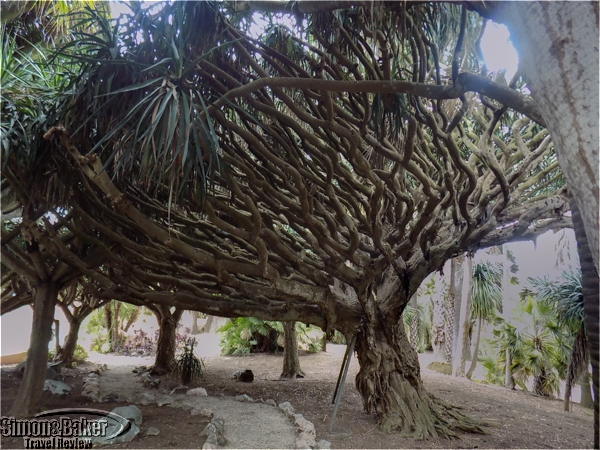
Although we thought of Lotusland as an oasis for desert flora and there were sections for dry-climate trees like palm and olive, it was also lush with a wide variety of plants of other climes.
We thought of Lotusland as an oasis for desert flora and there were sections for dry-climate trees like palm and olive, but it was also lush with a wide variety of plants of other climes. Lotuses and lilies covered a pond in the Water Garden and the Insectary Garden attracted butterflies and insects that have helped gardeners avoid using pesticides. Ferns shared shade with broad-leafed begonias (whose asymmetrical leaves are unique to the plant world in not matching), while other sections were devoted to cypress trees and roses. Mature dragon trees, whose branches reached almost vertically toward the sky, were striking and emitted a red resin known as dragon’s blood, used in folk medicine and favored by Roman gladiators to give them a fierce appearance. Lotusland had one of the most significant collections of bromeliads in the United States, a diverse family whose members trap moisture. They were clustered in several of the gardens, ranging from Spanish moss to pineapple.
One area in transition was the Blue Garden, which Walska had stocked with blue and silver-gray foliage. Tall trees had blocked the sun and the area was being replanted.
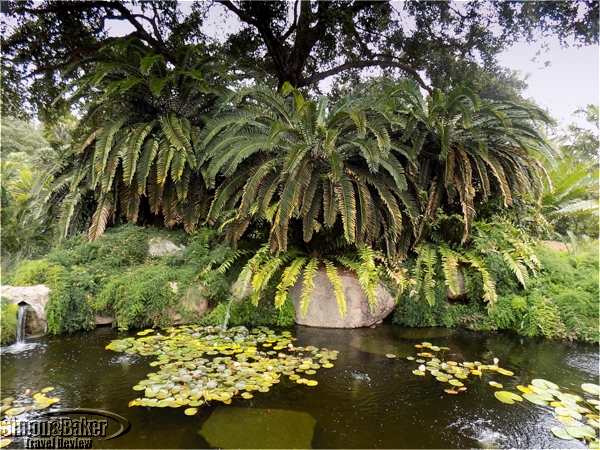
Three of the rarest plants on the planet, giant cycads
The most important section was devoted to the cycads, plants found in the fossil records going back 300 years, whose enormous cone-like reproductive structures called strobili (some weighing 30 pounds) were eaten by dinosaurs. Individual plants are either entirely male or female and may live as long as 1,000 years. They have stout, woody trunks that are often under the ground, while the foliage emerges from the top and grows in a rosette form, so they can look somewhat like ferns or palms. There were 900 specimens in the Cycad Garden.
In 1977, Walska auctioned her jewelry to pay $980,000 for two of the rarest plants in the world, two encyphalartos woodii cycads. Another was added later at an undisclosed price. Five were left in the world, all in private hands and all of one gender. It was believed that there were none left in the wild.
The horticultural wonderland of Lotusland impressed us. We were constantly surprised by the garden’s rare species, the exotic appearance of so many plants, and their beauty (not to mention the interesting story of Madame Walska). We now understand what she meant when she said in her autobiography that she was “the enemy of the average.” We look forward to exploring other gardens across the world.

by Editor | Aug 5, 2019 | Attractions, Ecotourism, Luxury Travel
Article and photos by Elena del Valle

Wayne Allanson aboard our 10-seat KeelowCraft on the 52 kilometer Waiatoto River in New Zealand
I didn’t know quite what to expect during the off the beaten track Waiatoto River Safari in the 355,000 hectare Aspiring National Park, part of the United Nations Educational, Scientific and Cultural Organization (U.N.E.S.C.O.) Te Wāhipounamu World Heritage Park in the South Island of New Zealand. My first clue was Ruth Allanson’s smile when we stopped to check in and sign release forms. It lit up her face and put me at ease. She and Wayne, her husband, owned the company.
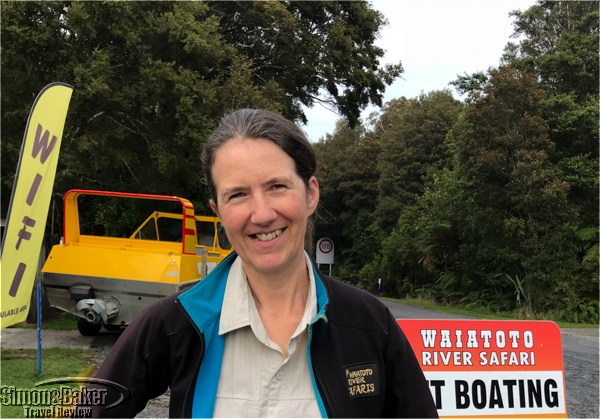
Ruth Allanson of Waiatoto River Safari

During the tour Wayne stopped in a sheltered corner of the river to tell us about the park.
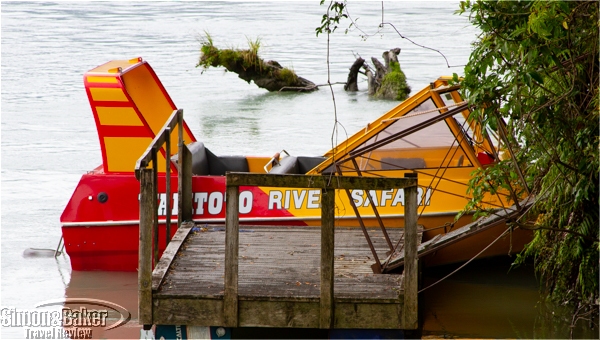
Our departure point
The simple indoor stand housed a desk, promotional brochures and a few local stonework souvenirs. From there a two minute drive led to our departure point, where moments later we met Wayne on the bank of the 52 kilometer Waiatoto River. We were 23 kilometers from Haast and about 200 kilometers from Queenstown.
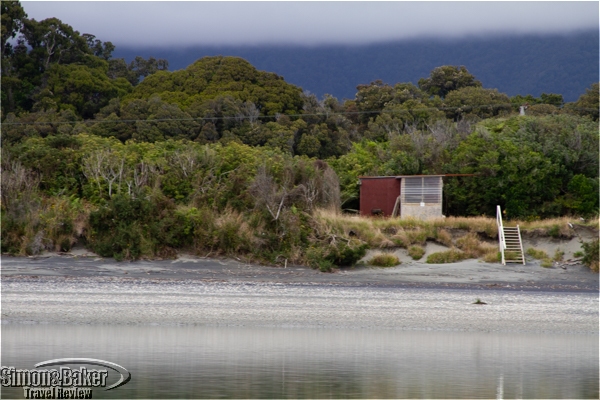
The Waiatoto River, 23 kilometers from Haast and about 200 kilometers from Queenstown
Although it was a clear summer day when we arrived (by the time we returned clouds had descended) there was a chill in the air that promised it would be cooler still on the boat. After applying liberal amounts of insect repellent against the sandflies and donning a loaner coat and I was ready. Veronika Vermeulen, owner of Aroha New Zealand Tours and my guide on an Intrepid tour of the South Island, and I followed Wayne onto a 10-seat KeelowCraft for our two and a half hour private tour. Our boat was 5.7 meters long, 2.2 meters wide, required 125 milliliters of water to operate, and could accommodate up 11 passengers plus driver. It had a Chev 350 V8 petrol engine with a Hamilton 212 jet pump.

The Waiatoto River, part of the U.N.E.S.C.O. Te Wāhipounamu World Heritage Park – click to enlarge
The setting was beautiful. The tour was one of the highlights of my trip to the South Island. The river and lush green vegetation were all around us. After the many crowded attractions we had passed on previous days it was wonderful to be alone on the river. This was in part because the tour was the only way to visit the unspoiled area by land and water. Later Ruth explained by email that the scenery and nature are unique to New Zealand.
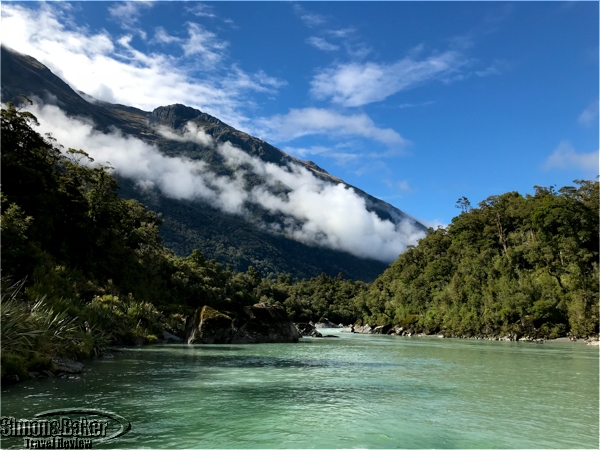
One of my favorite aspects of the tour was that we were the only people visible on the river.
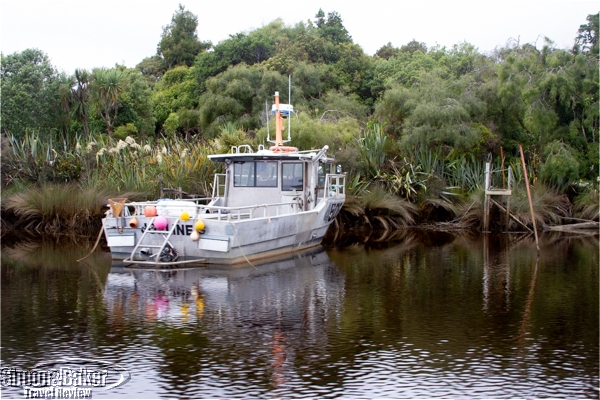
One of few boats we saw although during the whitebait season hundreds of locals descended on the river for their share of the popular fish
The loud engine sounds ensured we focused on the scenery rather than conversation. Wayne slowed down or stopped to show us points of interest, share information and indulge my photo needs. On one of the stops he offered us whitebait snacks. During the whitebait season, hundreds of locals descended on the river for their share of the tiny fish. Although it was past whitebait season Ruth and Wayne had a frozen supply from which they made the snacks.
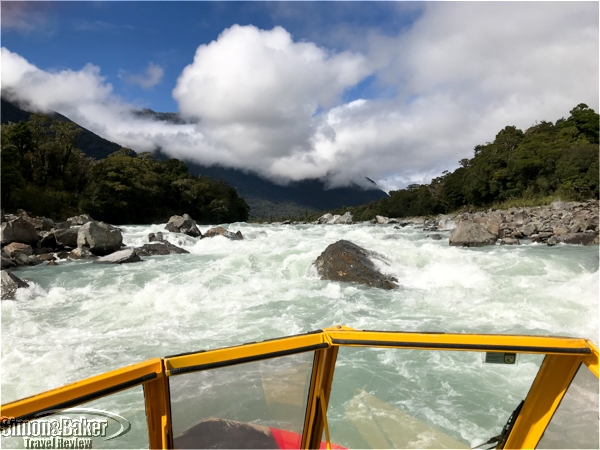
White water on the Waiatoto River
We covered 23 kilometers until the rapids became impossible to navigate. There Wayne tied the boat to the shore. It was easy to step onto land through the front of the boat. Veronika and I gazed at the rushing water, while Wayne secured the boat. Once he joined us we walked 500 meters into the quiet landscape before heading back down the river to the Hindley Stream. By the time we returned to our departure point we had covered 50 kilometers during the tour.
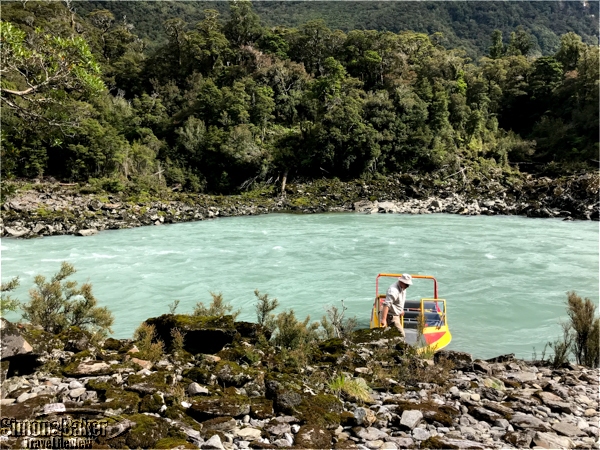
When the river became unmanageable we stopped for a short stroll.
It was nice to know the boats operated with Qualmark Environ motors specially imported for their low fuel use and clean running. I saw no pollution in the water or on land. The Allansons encouraged their clients to “take photos and leave footprints only.”
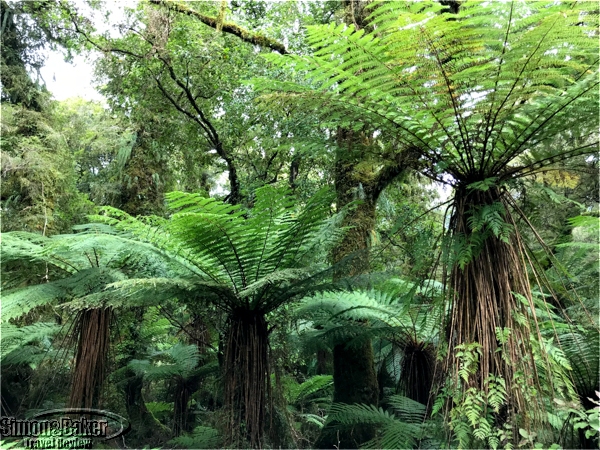
We encountered lush greenery on our short walk.
With advance notice they were able to accommodate some travelers with disabilities. Babies from about 5 months old (provided the life jacket fit) could join their tours and there was no upper age restriction. Life jackets were available up to XXXXL.

At our first stop – click to Enlarge
Once we glided over the river I was glad for the extra loaner layer and the safety of the life vest. Although at one point there were sandflies, perhaps because of the copious quantities of natural repellent I lathered on, they didn’t bother me at all. Waiatoto River Safaris Limited (975 Haast-Jackson Bay road, Hannahs Clearing, Haast, 7844, New Zealand, +64 3 7500 780, www.riversafaris.co.nz, info@riversafaris.co.nz) was owned and operated by a local family since 1997. Theirs was the only company with permission to offer boat tours on Waiatoto River (helicopter companies were allowed enter the park). Ruth and Wayne held Martime New Zealand commercial jet boat licenses, first aid and commercial pilot licenses as well as airplane instructor ratings. They had 12 years of jet boating experience.
According to the U.N.E.S.C.O. website, Te Wāhipounamu World Heritage Park covers 10 percent of the landmass of New Zealand. It has fjords, rocky coasts, towering cliffs, lakes and waterfalls. It was worthy of a detour. I especially enjoyed seeing it by boat.
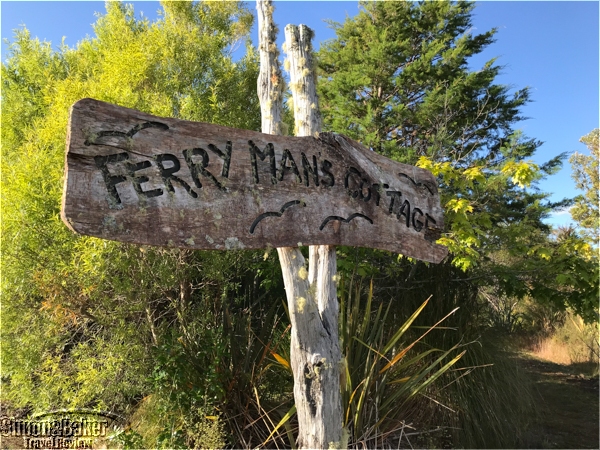
by Editor | Apr 22, 2019 | Accomodations, Ecotourism
Article and photos by Elena del Valle

A panoramic view of the cottage and its grounds (click to see full size)
During a recent trip to the South Island of New Zealand I spent two nights at Ferry Mans Cottage, part of the 40-acre Birds Ferry Lodge and Ferry Mans Cottage (163 Birds Ferry Road, Westport, New Zealand, +64 21337217, birdsferrylodge.co.nz, info@birdsferylodge.co.nz) luxury boutique lodge established in 2004 by Alison and Andre Gygax. They had embarked on the development of the property relying on Alison’s love of cooking and her degree in hospitality as well as Andre’s 15 years of experience as a South Island tour guide.
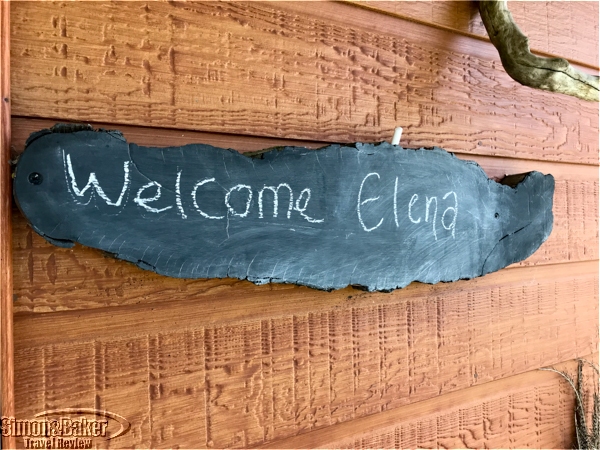
A sign by my cottage door
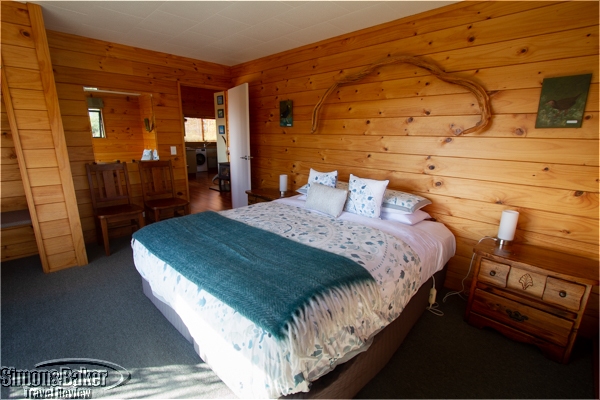
One of two bedrooms at Ferry Mans Cottage
From the main house it was a short stroll to my two-bedroom one bathroom northwest facing 1,200 square foot (estimated) cottage. Although at night the road that connected the cottage with the lodge was rather dark during the day it was an easy sunlit walk. On the first night I had dinner in the lodge with other guests and my tour guide. I enjoyed a refreshing pinot noir on offer along with several cheese filled dates Alison prepared. Dinner was a set menu.
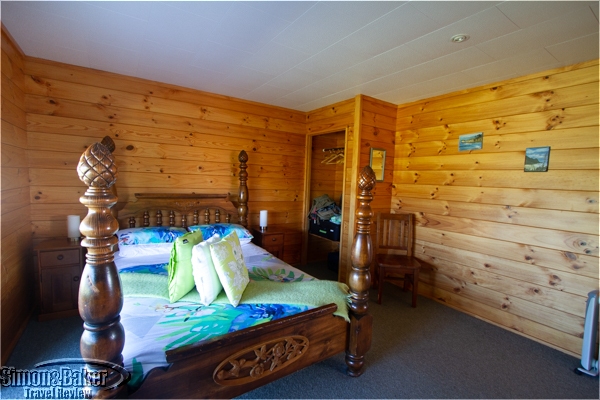
Another bedroom
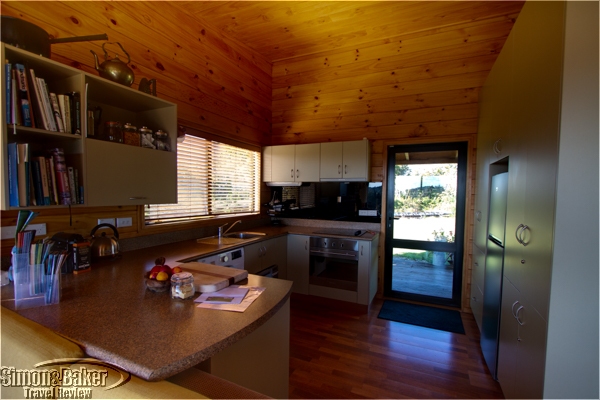
The well equipped kitchen included a washer and dryer.
Andre and Alison served snacks and drinks at 6:30 p.m. sharp to everyone together before we dined at a shared table in the lodge main room. Because in the evening there were mosquitoes and sandflies, when we stepped out on the terrace to admire the sunset we were invited to apply repellent. At the conclusion of the meal, two guests climbed into the lodge hot tub in the back porch. I returned to Ferry Mans Cottage.
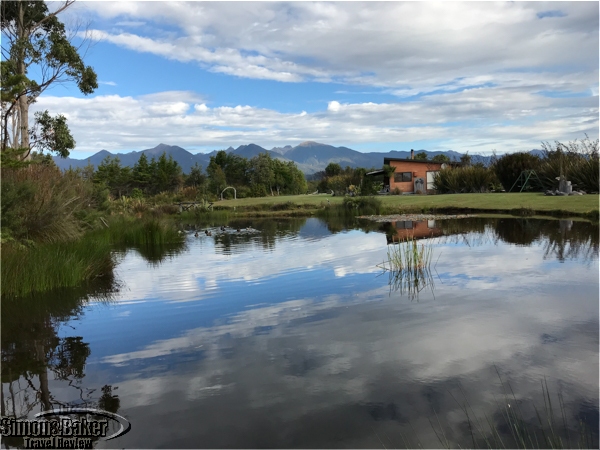
A view of Ferry Mans Cottage from across the manmade pond
The night of my arrival the owners explained that a photography team was scheduled for the following day, asking if I would mind if they photographed my cottage while they were there. That meant making myself absent from the cottage during the only full day I would spend at the property (check out was at 10 a.m. the following morning). I got the impression the photos were important to them so although it was inconvenient I agreed, ensuring my belongings remained packed before I left for breakfast at 8 a.m., earlier than I had planned to go out. Later I found out the photos were necessary because the property was for sale. The “Business will sell as a going concern and we will be involved in the handover to ensure all services and standards remain,” Alison replied by email when I asked about the listing.
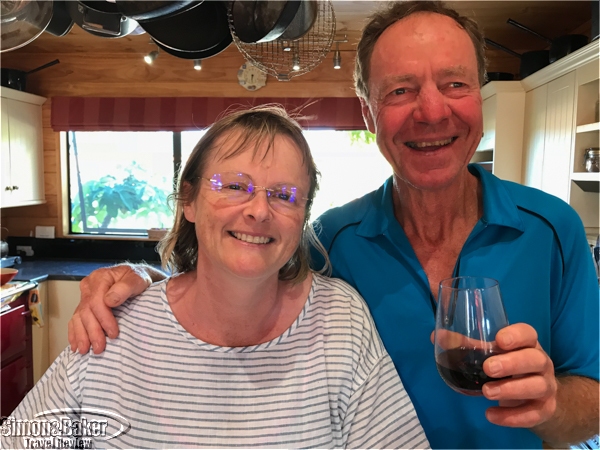
Alison and Andre Gygax in the Birds Ferry Lodge kitchen
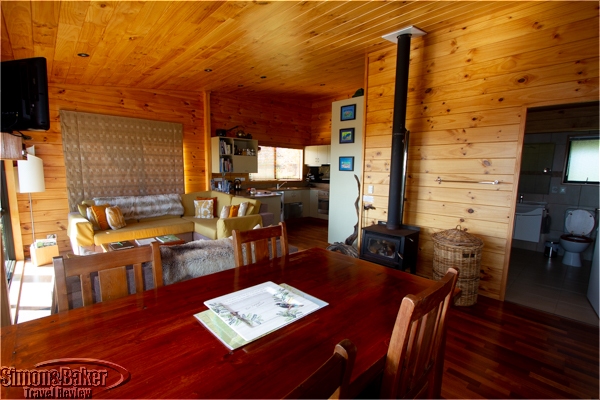
Inside Ferry Mans Cottage, including the dining table, fireplace, sofa, bathroom and kitchen

The main course at dinner
Perhaps my favorite feature of the handicapped friendly cottage was its serenity and its views to the onsite rain forest from the back, and to an expansive lawn and a pretty manmade pond from the front. Cottage amenities included WiFi (limited to 500 megabytes), television, fireplace, homemade cookies, fruit bowl, and well equipped kitchen, including a washer and dryer. I was strongly urged to hang my clothes on an exterior clothesline instead of using the dryer to conserve energy. Since they didn’t want to photograph the cottage with my clothes hanging from the clothesline the owners agreed to hang the clothes at the end of the photo shoot. When I returned that evening they were damp and crumpled in the hamper.
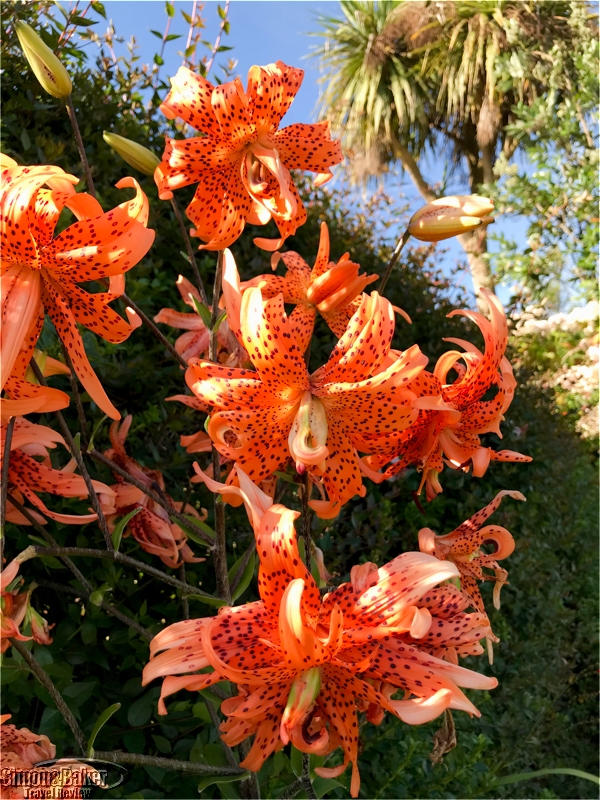
One of the many pretty flowers in the lodge’s kitchen garden
Children and “well behaved pets” were welcome in the cottage. Cottage guests could prepare their own dishes in their private kitchen or request meals in advance from the lodge. Alison used as many fruits and vegetables from her garden and ingredients from local producers as she could in the meals, she explained later. Breakfast consisted of continental options as well as cooked to order pancakes or eggs and sides.
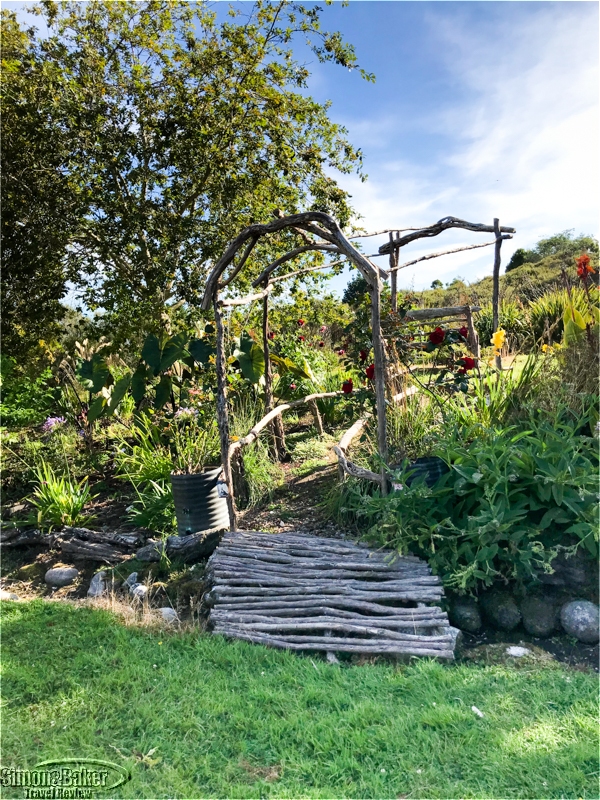
Alison used as many fruits and vegetables from her garden and ingredients from local producers as she could in the meals.
On request it was possible to visit the kitchen garden and the rain forest. I visited the garden in the morning while the photography team was in my cottage. In the early evening, Andre guided me through the rain forest until we were caught by rain showers. He pointed out scented orchids, sterile moss, berries, rimu and beech trees.

During the day, the road that connected the cottage to the lodge was an easy walk although at night it was rather dark.
One of the property features I liked was that the owners were kind to the environment, recycled whenever possible, including plastic, metal, glass, cardboard and paper. They fed kitchen scraps to their chickens, harvested their own water, used solar water heating, and relied on a chemical free cleaning system.
by Editor | Nov 5, 2018 | Attractions, Ecotourism
Photos by Gary Cox and Elena del Valle
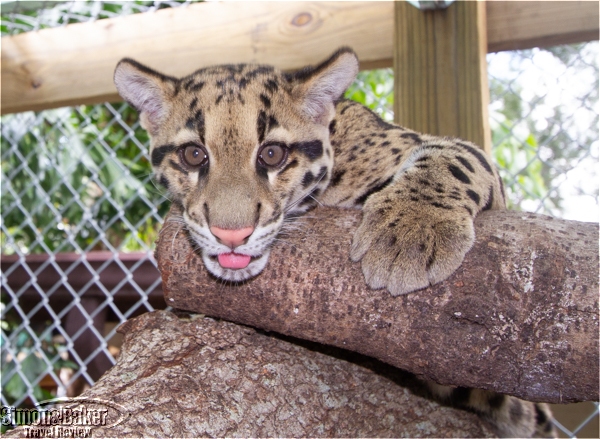
Despite the subtropical heat the sisters were surprisingly relaxed.
We recently spent a few precious minutes inside an enclosure with Lura and Malee, two female clouded leopard (nebulosa) cubs at Panther Ridge Conservation Center (2341 D Rd Loxahatchee Groves, Florida 33470, +1 561-795-8914, www.pantherridge.org) in Florida. A warning about how sharp their teeth were did little to dampen out enthusiasm once we had caught sight of the junior cats through the chain link fence of their enclosure. Lura, seven months old, and Malee, five months old, looked healthy and were full of energy, mock stalking each other and jumping with ease from one side to another. Despite the heat the sisters were surprisingly relaxed, allowing us to watch them and take photos as they played. Their brother was unable to join us because he was recovering from an injury.
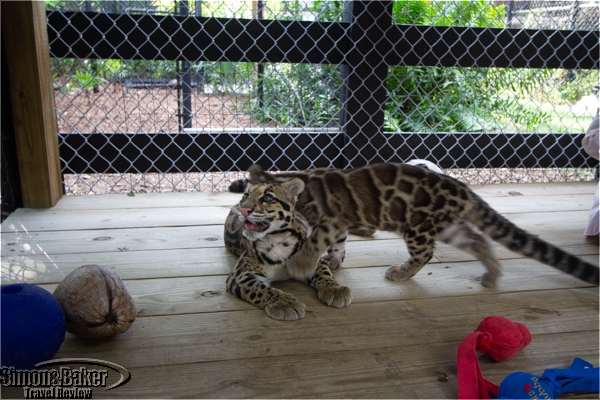
Lura and Malee played while we watched.
Clouded leopards are beautiful and like so many species may be in danger of disappearing in the future. According to CloudedLeopard.org, a Washington State nonprofit (per its website), in 2014 there were only 166 clouded leopards in zoos in the world, including 37 of them in the United States.
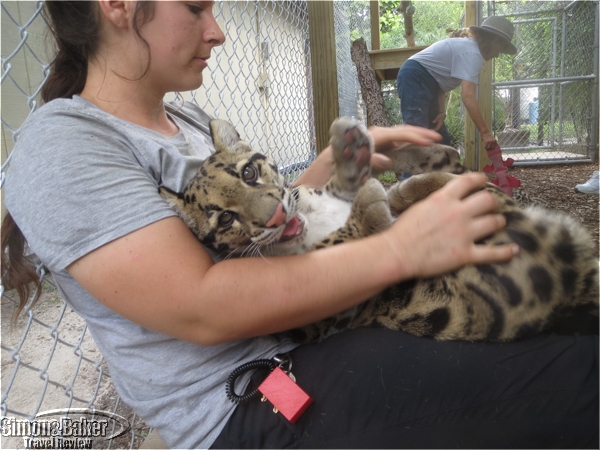
Sadie Ryan, head keeper and facilities manager, holding one of the cubs in her lap
To raise funds for its residents and increase feline awareness Panther Ridge offered tours by appointment and private time with the clouded leopards. Special thanks to Sadie Ryan, head keeper and facilities manager, and Barbie Jetter, assistant director, who welcomed our photographers at their center during an especially busy period. The staff and animals were in the midst of a cumbersome move from Wellington to Loxahatchee in Palm Beach County.
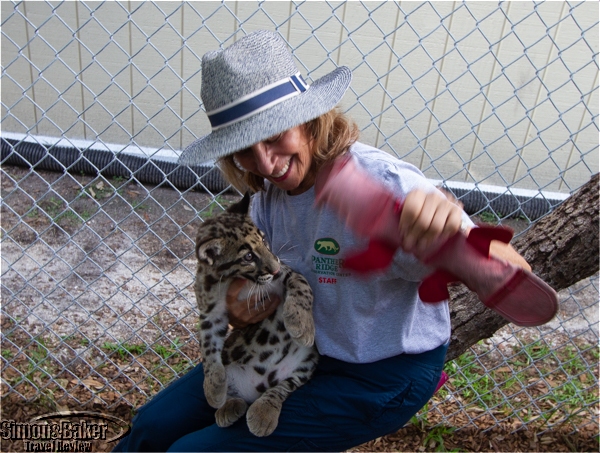
Barbie and one of the cubs
According to the International Union for Conservation of Nature Red List (IUCN), clouded leopards are Vulnerable. The Swiss based membership organization defines the term as “facing a high risk of extinction in the wild.” Although exact numbers seem elusive one website estimated only 10,000 of them remain in the wild.
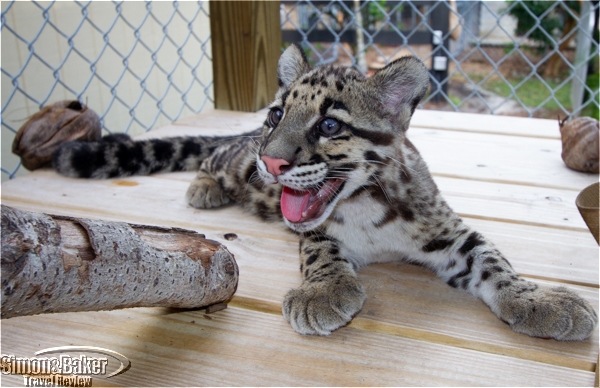
According to the IUCN Red List clouded leopards are Vulnerable.
Panther Ridge is a 501(c)(3) nonprofit dedicated to combining “feline husbandry with conservation awareness to educate the public on wild felines.”
by Editor | Jun 26, 2018 | Attractions, Ecotourism
By Elena del Valle
Photos by Gary Cox*
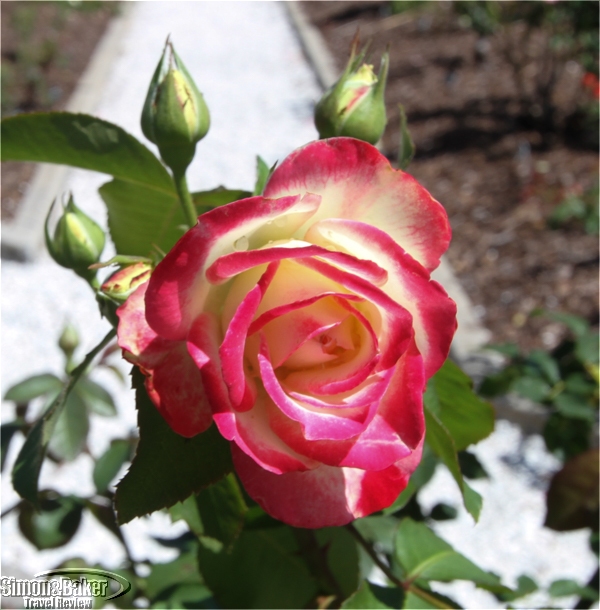
On a spring visit to the John and Mable Ringling Museum of Art in Sarasota, Florida we discovered the Mable Ringling Rose Garden (John and Mable Ringling Museum of Art, 5401 Bay Shore Road, Sarasota, Florida 34243, +1 941-359-5700 ext 2109, https://www.ringling.org/, Karen.smith@ringling.org). It was one of those sunny yet chilly and breezy days that is perfect for outdoor strolling. We saw the garden on our way to John and Mable’s storied home, now a museum, and made a point of stopping.

A signs described the history of the rose garden.
It was one of the highlights of our visit. I especially enjoyed the often fragrant flowers in 18 hues (the American Rose Society recognizes 18 colors of roses, a Ringling spokesperson explained by email), each with a name tag at the foot of the bush. The new name tags indicated if the rose was fragrant, Karen Smith, MSc., curator since 2015, Mable Ringling Rose Garden, explained when I asked about a particular flower a volunteer had suggested I see.
Flower fragrance is not a straightforward matter it turns out. It varies, according to the ratings of the American Rose Society, from Strong, Moderate and Mild, to None. So many roses were scented I was not surprised to discover 81 percent of the roses had some scent.
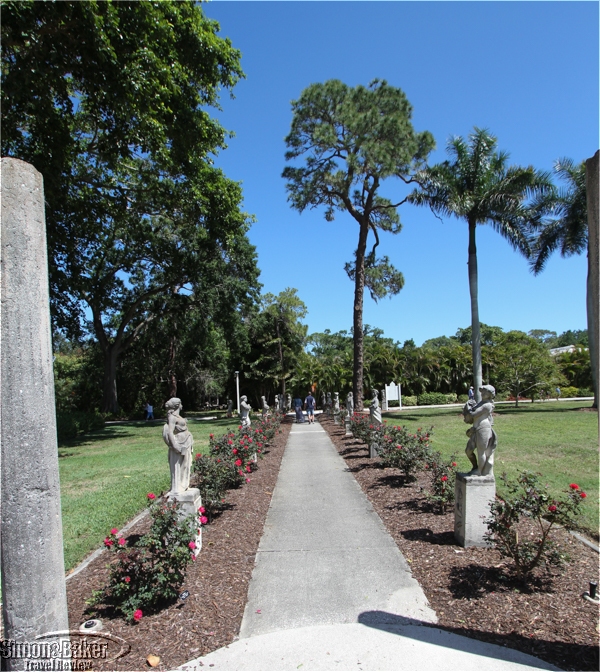
One of the paths lined with statues
At the time of our visit, excluding the miniatures and miniflora’s, 40 percent of the roses had a Strong scent, 19 percent Moderate, 22 percent Mild and 19 percent had no fragrance.
Ms. Smith is a former research scientist in the neuroscience field. Throughout thirty years in science, horticulture was always a part of her life. Care of the garden was no accident. Although she was the only employee dedicated to the garden when needed six estate gardeners were available to lend a hand. And 26 volunteers, including 15 seasonal visitors to the area, worked in the garden from three to 12 hours per month.
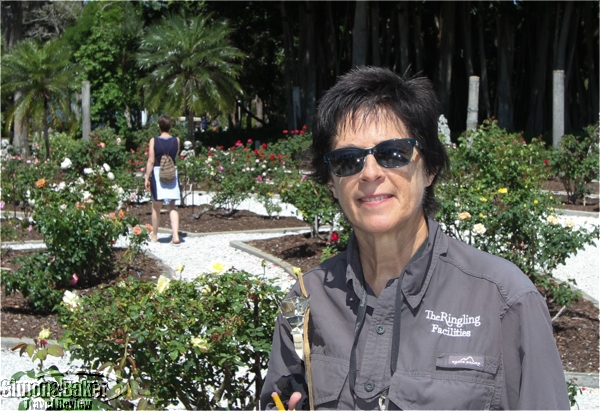
Karen Smith, MSc., curator, Mable Ringling Rose Garden
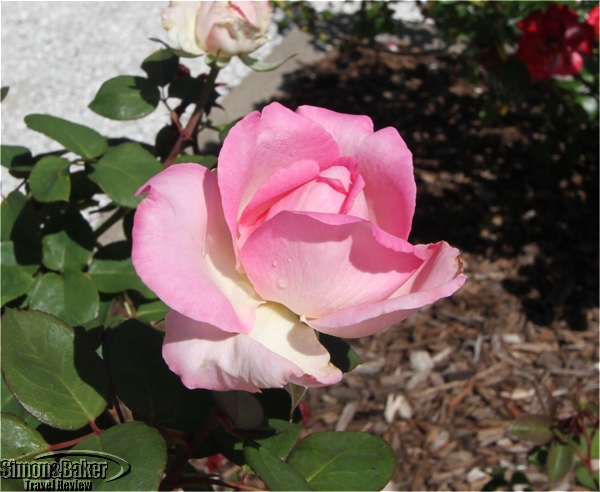
There are many challenges and stresses that can affect rose plants, the garden curator explained. She relies on Best Management Practices and a weekly monitoring system during which more than 100 bushes are inspected each week.
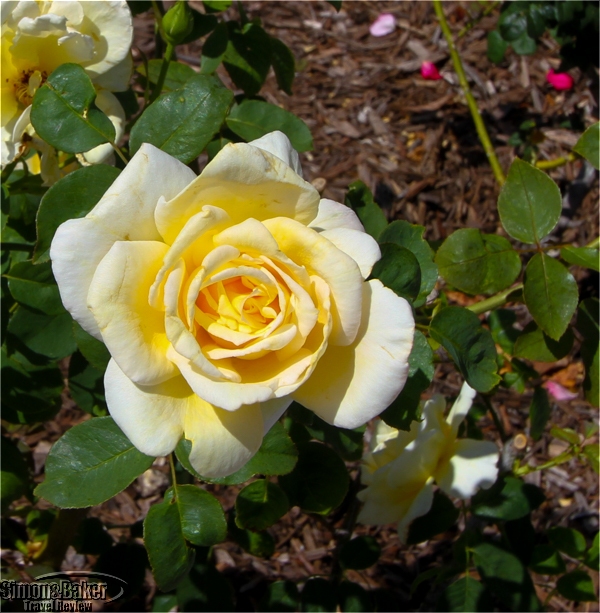
“A rating is given for pests and diseases,” she said by email. “If it is determined that the disease or pest is at a level that is unacceptable, treatment occurs. We use the safest treatment possible for each situation. For example when the weather is cool enough we will use Neem Oil as our pesticide for Aphids, Mites, Thrip, and Scale. Every spring we remove the old mulch and bring in 75 cubic yards of compost, fertilize, and re-mulch
When asked for fertilizer specifics she shared details generously, “Currently for fertilizer we use a 4-3-4 Turkey Manure (Mighty Grow) and 16-0-0 Blood meal – each four times a year. Supplement with a Sul-Po-Mag (0-0-22) twice a year. For example to fertilize once using the Mighty Grow takes 650 lbs.”
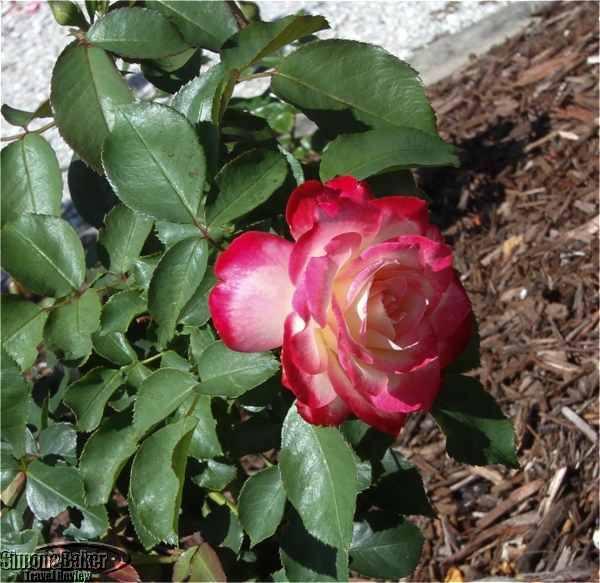
What are the best months to see the roses in bloom and at their most fragrant? December and January as well as March and April. In 2017 Hurricane Irma caused some damage to the garden so it was not at its prettiest during our visit.
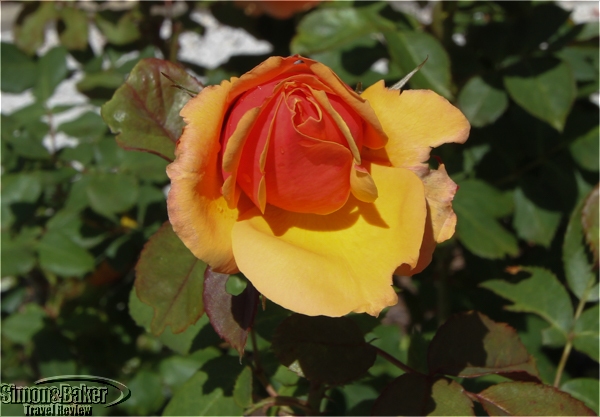
“We have two cut-backs a year, one in February and one in September, the garden curator said. “The large blooms occur approximately 8 weeks after cutback. It take us 3 weeks to complete the cutback- therefore the bloom is in phases comparable to the cutback.”
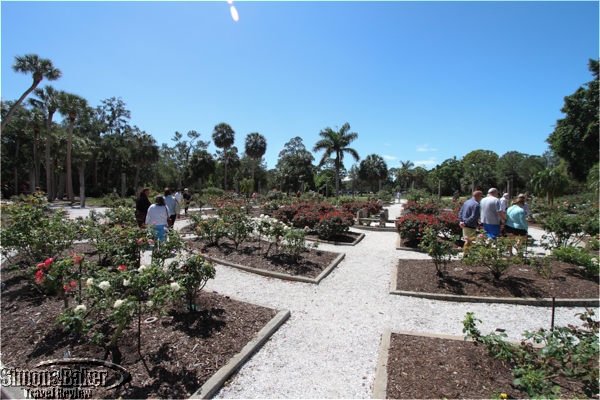
Many visitors strolled through the garden on the day of our visit.
We later discovered the garden dates back to 1913. Sadly, none of the plants from Mable’s era remain. The garden consists of 1,200 rose plants introduced between 1793 and 2002, among them Tree Roses, Hybrid Teas, Floribundas, Grandifloras, miniature roses, shrubs, Old Garden Roses (varieties introduced prior to 1867). Among them was a rose dedicated to Mable.
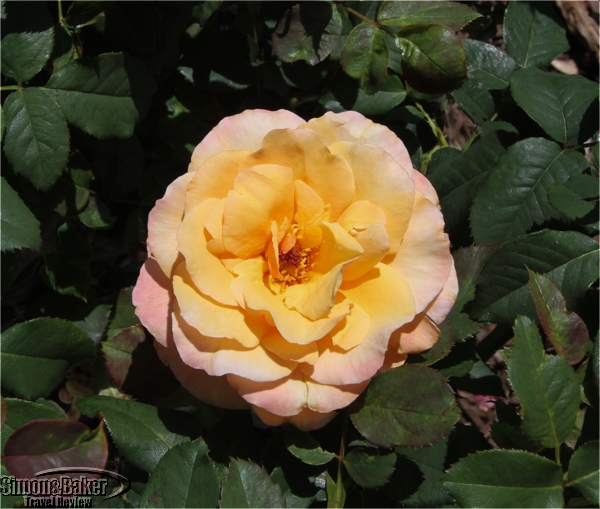
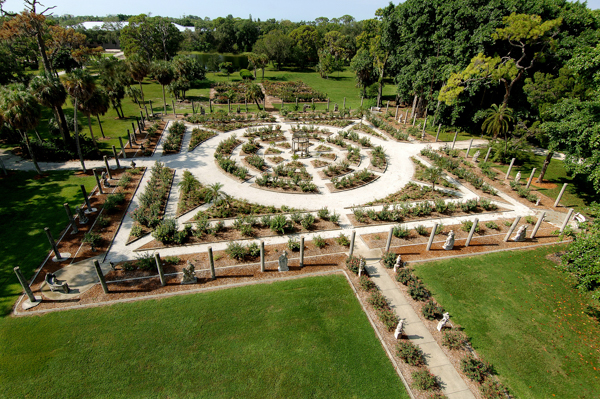
The Italian inspired Rose Garden has a circular wagon wheel design.
(Click photo to view full size)
The 27,225 square foot Italian inspired Rose Garden has a circular wagon wheel design and pathways lined with garden sculptures of courting couples in pastoral scenes. By the late 1930s the estate and the garden fell into disrepair. Many years passed before it returned to a state similar to the one we saw during our visit. By 2004 the garden was restored thanks to the efforts of the resident horticulturist, Ron Mallory and the volunteers he recruited.
It received accreditation from the All-American Rose Selections in 2004, and recognition in 2006 as the most outstanding All-American Rose Selections Public Rose Garden in the nation.
*Aerial photo of the Rose Garden (date unknown) courtesy of the John and Mable Ringling Museum of Art
by Editor | May 21, 2018 | Ecotourism
By Elena del Valle
Photos by Gary Cox
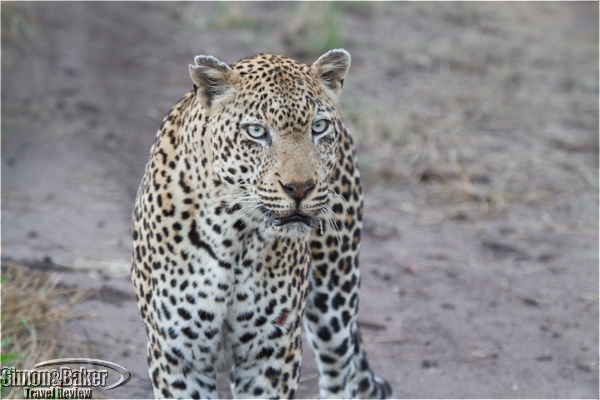
We go on safari to see nature. Thankfully that does not always mean missing out on exercise.
While on safari safety is a priority. Frequently wild animals, some of them dangerous, roam freely near the luxury lodges where guests stay. They may stroll through the property. This means that in many places staff escorts are required for guests at night and sometimes in the early morning around dawn. At the dozens of properties where I have stayed, with some exceptions, jogging and running were discouraged or not allowed. This makes exercising beyond in-room basic stretching difficult.
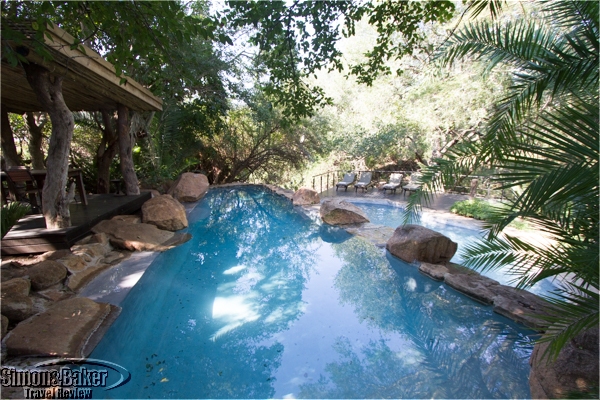
The two swimming pools at Singita Ebony were large enough for laps.
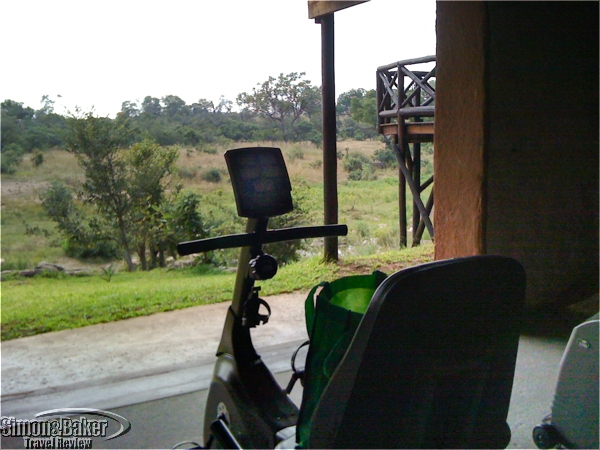
The workout room at Lukimbi was open air.
I suspect that many fitness aficionados smile with pleasure on discovering somewhere to safely stretch their legs while in the African bush. Yet running, jogging and exercise in general were difficult or not possible in many of the Big Five properties I have visited, especially in those without electric fences surrounding the property itself. That is why I remember the lodges with a full length swimming pool or a dedicated workout area with particular fondness.
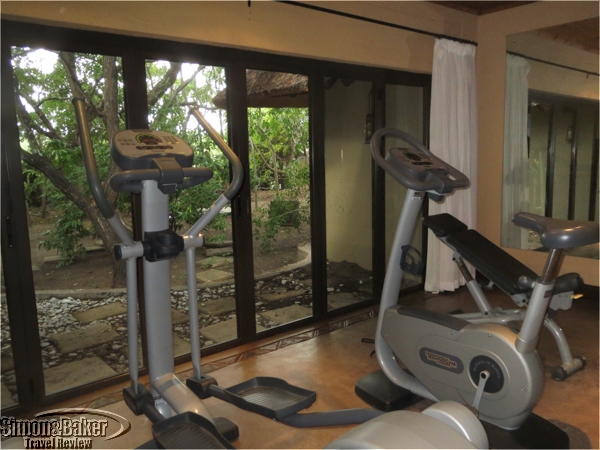
While at Fitzpatrick’s Lodge at Jock Safari Lodge we had access to the Jock exercise room a short drive away.
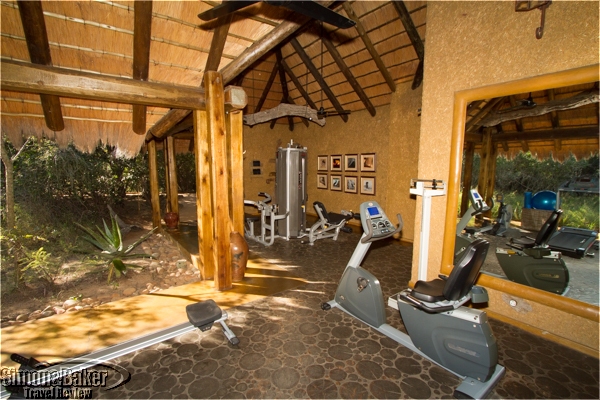
The open air workout area at Camp Jabulani was covered
While on safari days fly by in a blur of activities, mainly twice daily game drives and sometimes guided walks. Early mornings and three course dinners make finding time to exercise a challenge. For those willing to do so having a pool to swim laps, treadmill, elliptical machine or free weights can be the ultimate luxury. On our 2017 trip to South Africa, several five star safari lodges, Lukimbi Safari Lodge, Fitzpatrick’s Lodge at Jock Safari Lodge (www.jocksafarilodge.com, +27 (0) 13 010 0019, Fax +27 (0) 86 601 9961, Reservations@jocksafarilodge.com), Sabi Sabi Earth Lodge, Singita Ebony, Simbambili Game Lodge, and Camp Jabulani, had fitness facilities.
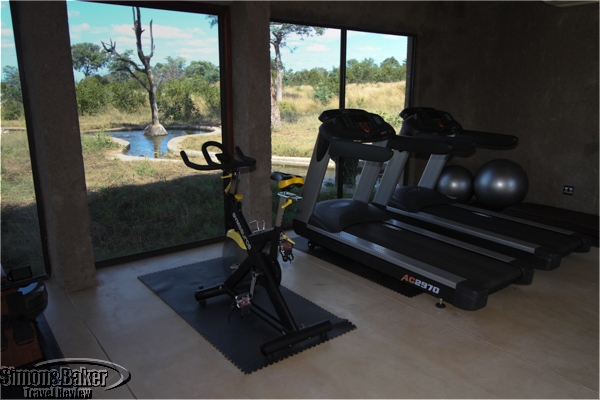
The air conditioned exercise room at Sabi Sabi Earth Lodge with a pretty view was a favorite.
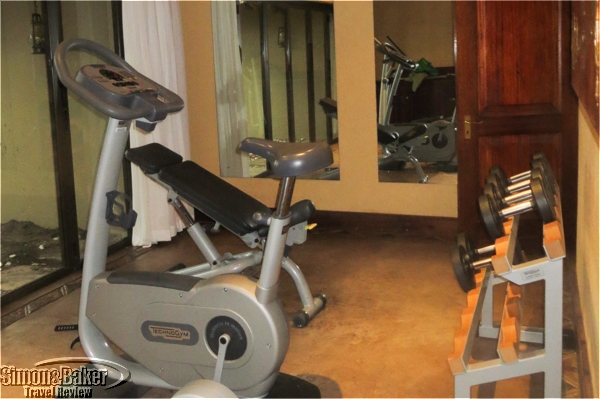
The workout room at Jock’s had a rack of dumbbells and a slanted bench
Lukimbi, on the southern end of the well known Kruger National Park, had an open air fitness and treatment room facing the lawn and bush across the Lwakahle River. The pool was visible from the workout room as well. The room housed a workout space with weights station, Running Machine, Cycle, and Step Machine.
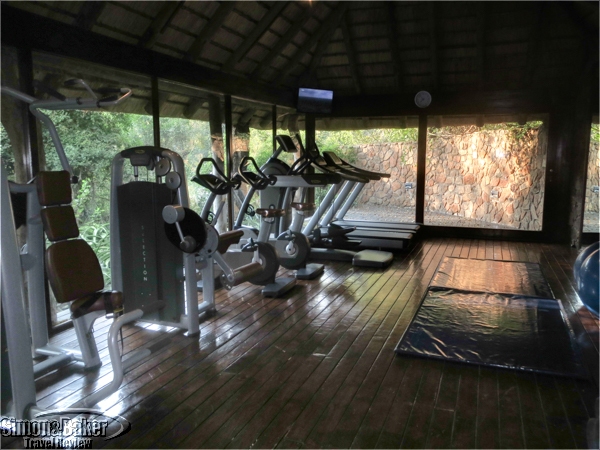
I liked the glass wall at the air conditioned Singita Ebony workout room, which was in the same building as the spa.
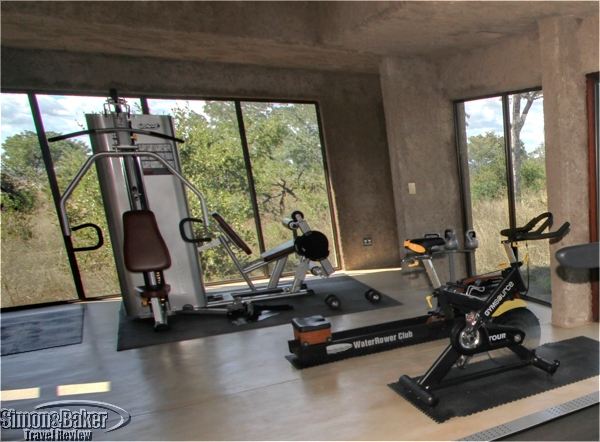
Earth lodge featured a variety of aerobic machines and a resistance circuit machine.
As a guest at Fitzpatrick’s I had access to the small workout room within the Jock’s Safari Lodge 150 square meter spa building. The sister properties were within a two minute drive. Anelda, our friendly host, kindly drove me over from Fitzpatrick’s to Jock’s. The visit also provided me an opportunity to browse in the curio shop as Fitzpatrick’s was too small for its own shopping space. When I was ready to return I asked the staff person at Jock’s to call her. Within minutes she picked me up. Thanks to the room’s glass wall I enjoyed bush views during my workout. A thirty minute careful jog along the property’s wet pathways (it rained during most of our three night stay) rounded out my morning.
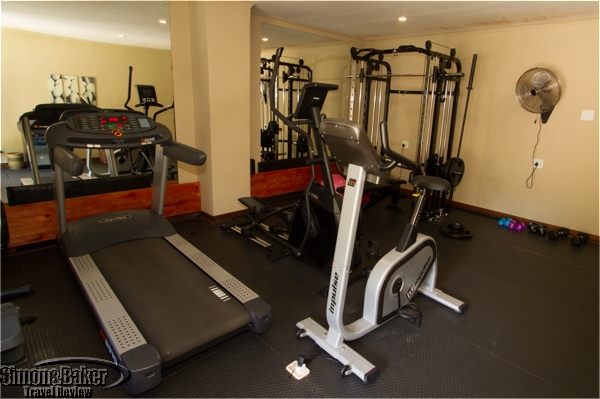
Simbambili had an indoor workout room in the same building as its meeting room.

While this cub could exercise safely in the reserve the humans had to stay indoors.
Sabi Sabi Earth Lodge, one of our favorite properties on that trip, had a dedicated air conditioned 50 square meter (5 meter by 10 meter) workout room in a stand alone building. Some of the workout room’s glass walls faced the bush and a water feature. I especially enjoyed watching the many birds attracted by the water feature in the morning during my workout. The fitness room housed two treadmills (Impulse AC2970), spinning bicycle (Gym Source Tour), water rower (Water Rower Club), Multigym (Impact FIT200 Classic), freestanding bench, Kettle Bells in two kilo increments ranging from four to eight kilos, two Pilates balls, three yoga mats. Amenities include chilled sparkling and still mineral water, Powerade, hand towels, sanitizing spray and paper rolls. I later found out there is an adjoining shower for guests who wish to freshen up.
“The beauty of the location of the gym is such is that it does not impact on the main lodge but is hidden away and also blends into the environment,” said Heath Thompson, lodge manager, via email when asked what makes the gym stand out. “The structure is built with the same concept as that of the main lodge with a natural, organic type structure and the majority of the gym is glass, with views of a waterhole – allowing for uninterrupted views of the bush veld whilst training or exercising. We have often had remarks from our guests who have spotted elephant drinking from the waterhole. The bird life is also phenomenal due to the availability of a water source.”
A fan of bush walks he added, “Whilst this performs the mainstream basis of keeping fit (from all that delicious food of course), there is also the opportunity to go on one of our environmental awareness walking safaris, so whilst this is not traditionally an ‘exercise’ based excursion and the idea behind this is to expose guests to a safari from a different angle and experience the “small stuff” that one generally misses whilst out on a an open vehicle, it does nonetheless necessitate walking (up to 1.5 hours). So whilst gaining a holistic experience of the African bush from a walking perspective, one’s body also benefits from the walking.”
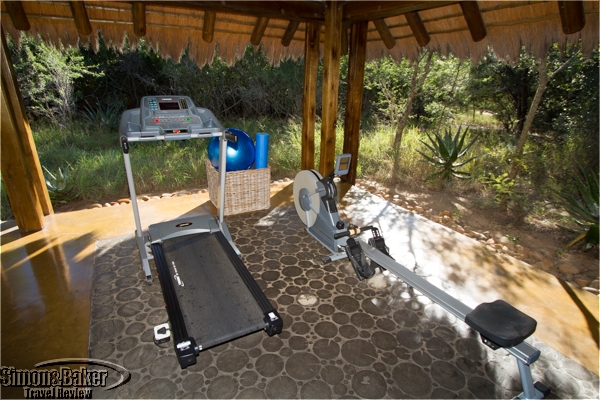
The workout machines at Camp Jabulani were under thatch next to the massage area.
Singita Ebony’s fitness room shared a building with the spa. The air conditioned space had wood floors, a row of machines, and a bush facing glass wall. In addition to our en suite heated private plunge pools (a favorite) Singita Ebony also had two common area swimming pools. Although the water was chilly it was wonderful to have a midday swim to offset the blistering summer heat.
“Singita Ebony Lodge has a very unique bush spa with gym attached,” said Chantelle Maritz, co-manager, Singita Ebony Lodge. “The two rooms at the spa are comfortable and decorated alongside the classic safari look with sliding doors that open. The gym side is a rock wall with large glass windows.”
The 49 square meter (11.3 meter by 4.3 meter) gym was stocked with individual size bottled water and coconut water, towels, television and two showers (shared with spa guests).
As of May 2018 the gym offered the following weights in kilos: 10 to 20 sizes, kettle bells in 4, 8 and 16 kilos, medicine balls in 3 and 5 kilos. There were: foam roller, five floor mats, yoga block, two wellness balls and Technogym equipment: bench, two treadmills, two exercise bicycles, multi-functional trainer, shoulder press machine, chest press machine, cable station, leg extension, and vertical traction machine.
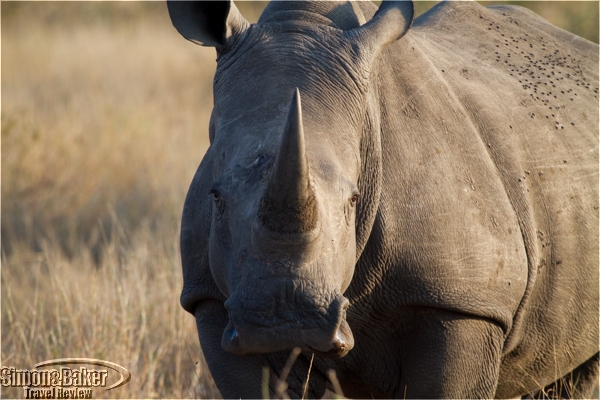
While seeing the animals is still the best part being able to exercise is healthful.

Camp Jabulani had a steam room and sauna.
Our three-bedroom, three bathroom Zindoga Villa accommodations at Camp Jabulani were so spacious and comfortable I had little need to spend time in the common areas with the exception was the dining room at meal times. The pretty 53 square meter open air workout area, equipped with: Johnson multipurpose machine, static bicycle and Johnson rowing machine, Trojan treadmill, six sets of free weight Trojan dumbbells and Detecto scale, was inviting. There was also a new looking six square meter sauna with a glass wall. Had we spent another night at the property I would have made time to work out; and should we plan a future safari trip to the area Camp Jabulani will be high on my list, among other reasons, for its workout facility. For more South Africa safari properties with workout facilities when we were there see Safari properties that offered exercise facilities among favorites.








































































